Whats A Hip Turn Part 2?
- by Kelvin Miyahira
(This article is Part Two of "What's a Hip Turn?" Part One is here.)
Hip/Leg Movements Part 2: The Complexification
Warning: Reading the contents of the second half of this article will be extremely technical. If you don’t like the technicality, you don’t want to read any further.
I have done the hard part of deciphering the genetic code of the legends’ golf swings and while it is very complicated, I have also done the work to simplify it so everyone should be able to understand. This month I’ll do things a bit backwards by detailing the movements of the downswing and next month I’ll go back and describe the movements of the backswing.
As I shall show later, these powerful movements of the hips not only pertain to golf, it applies to baseball pitching/hitting, tennis serves/groundstrokes, sprinting, and many other sports requiring rotations. The premise here is that the movements originate in the lower spine and pelvis, then to the ground and back up vs. the universally accepted norm of all movements start from the ground up.
This is certainly not common knowledge because we have ASSUMED events were occurring when something completely different was occurring.
Definitions
Before I can describe the movements, I have to define the types of articulations the hips/legs can make. As it is the golf lexicon is filled with as much ambiguity as Androgynous Pat from Saturday Night Live. So let me define some terms and once we can all understand the terms, we can more easily determine what’s going on and why.
Also, muscles can articulate different movements depending upon their positioning in relation to their attachments and which part of the muscle is at work. For example, the gluteus maximus can externally rotate the hip or extend the hip depending upon the position of the femur (thigh bone) or when it receives a pulse to start a stretch shorten cycle. That is why the movements are going to be a bit difficult to distinguish at times but we’ll have to rely on position of the bones, joints and research that has already been done in this field.
Pelvis vs Hips
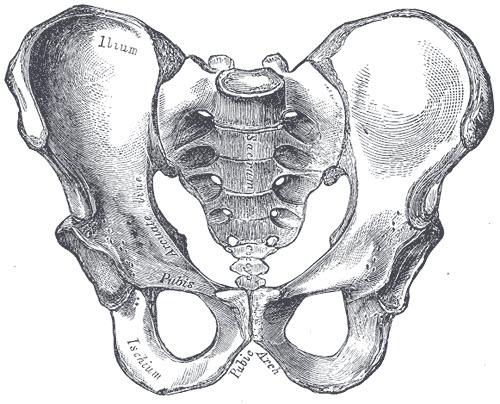
The pelvis is the section of the body between the legs and the torso that connects the spine (at the sacrum) to the thigh bones. Thus, the pelvis and the musculature attached to is considered part of the spine engine.
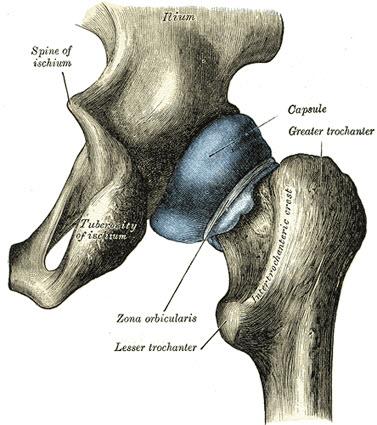
The hip refers specifically to the acetabulofemoral joint or where the acetabulum meets the femur. The hip is a ball and socket type joint with the ability to move in three degrees of freedom or three different planes of motion which are called flexion/extension, lateral/medial rotation (which we shall call external/internal rotation for simplification purposes) and adduction/abduction. We will also need to cover the knee and femur position as well since they can also influence movement at the hip.
The key to this is that the pelvis/spine can rotate independently of the legs but only to a limited degree if legs do not support and facilitate rotation. This can certainly blur the line between the legs, hips and pelvis. They can either work together to create wonderful rotation or fight each other to inhibit rotation.
Three Planes of Movement
Flexion/Extension
Hip Flexion
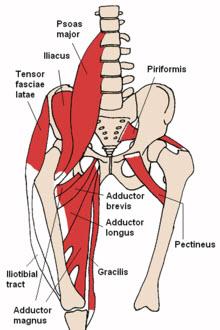
Flexion is defined as bending the joint resulting in the top of the pelvis moving forward. The main muscles that cause hip flexion are the psoas major/minor and the iliacus. There are other muscles that act on the femur that can aid flexion but we shall focus on the major muscles for now.
The way to view these muscles, joints and bone movements is to envision what would happen in a muscle contraction. As these muscles contract or shorten, they will not simply move on only one axis. For example, the right psoas major when contracted will pull the hip into flexion but also due to its position of the right side of the spine and connection to the left side of the femur will also aid in pulling the right leg in toward the center (adduction).
Hip Extension

Extension is the opposite movement with the bending of the joint causing the top of the pelvis backward. This is the posterior (back) view of the pelvis showing the gluteus maximus which is the main muscle moving the hip into extension.
Abduction/Adduction

Hip abduction (AB) occurs when the femur moves out toward the side or moving the thighs apart. The muscles involved are the gluteus medius, gluteus minimus, tensor fasciae latae and the Sartorius.

Hip adduction (ADD) occurs when the femur moves back toward the midline of the body or moving the thighs in. Major muscles involved in ADD are the adductors, pectineus, gracilis, and the gluteus maximus.
External/Internal Rotation
External Hip Rotation
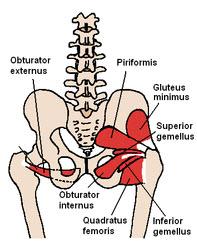
External rotation of the hip (ER) is the rotary movement around the longitudinal axis of the femur away from the center of the body or turning the thighbone outward. The main muscles used in ER are the gluteus maximus; quadratus femoris; obturator internus; dorsal fibers of gluteus medius and minimus; iliopsoas (including psoas major from the vertebral column); obturator externus; adductor magnus, longus, brevis, and minimus; piriformis; and sartorius.
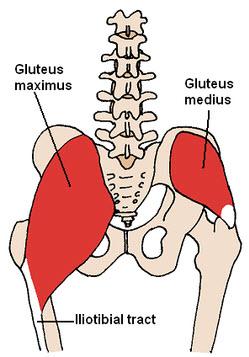
Internal Hip Rotation
Internal rotation of the hip (IR) is the opposite movement or turning the femur inward. There are no prime Internal Rotators. However, there are several secondary movers including the anterior fibers of the gluteus medius and minimus, the adductor longus and brevis, the pectineus, the medial hamstrings (semitendonosus and semimembranosus) iliacus, psoas major and the tensor fascia latae.
What you talkin’ ‘bout Willis?
If you’ve been paying close attention to the list of muscles (many of you have glossed over them), there are many muscles that can be used in different ways to produce different movements. The possibilities are many.
Many times, these movements do not coincide with the timing of the movements in the golf swing. For example, the gluteus maximus externally rotates and extends the hip. But these movements do not simultaneously occur in the golf swing. During early downswing the legends used a squat move that is using external hip rotation and hip flexion, not hip extension. So what are the glutes doing?
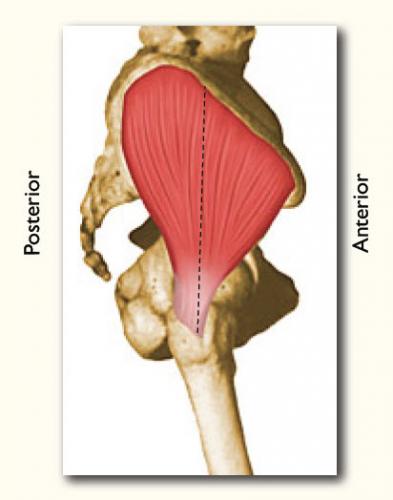
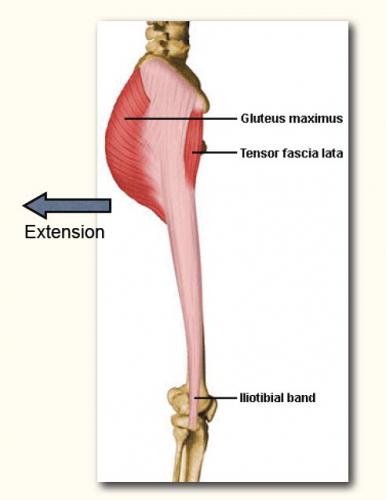

This is truly the genius of the human body that can do this. The major muscles of the spine engine are multi-planar and much more complex than your bicep! This is because the hip joint is a ball and socket type of joint (synovial) that has a large amount of three dimensional movement available and the muscles’ positioning on the pelvic bone, spine and femur affect how the muscle will move.
The key is using these muscles correctly to create the correct motion in one plane while creating a stretch in another plane of motion to fire once again.
For example, during the squat move, the firing of the anterior fibers of the gluteus maximus produces external rotation of the hip while the posterior fibers are being stretched to create a SSC for the hip extension later in the downswing.
Also, the superior (upper) fibers of the gluteus maximus aid in AB in early downswing while stretching the inferior (lower) fibers of the gluteus maximus in ADD that are being stretched to generate a SSC for the hip adduction later in the downswing.
Notice that the gluteus medius and minimus can be used for ER or IR depending upon whether the anterior (front) or posterior (back) fibers are primarily used.
Luckily some muscles are can aid in two motions that occur at the same time in the golf swing. For example, the iliacus and psoas major can cause flexion of the hip and aid in external rotation at the same time.
Thus, the human body is an extremely complex machine with many different combinations of movements possible. We shall look at the legendary swing in great detail as well as some less than optimal movements.
Let’s start with the movements in transition and early downswing.
Transition and Early Downswing Moves
What occurs in transition in both leg/hips is external rotation, Abduction (AB), hip flexion (bending hip bone down) and leg flexion (bending the knees). Let’s take a closer look at these moves along with some less than optimal movements that non-legends use.
Note: Some of these set up moves create a stretch shorten cycle (SSC) automatic firing and some of the moves produce an anatomical positioning that is optimal for the next firing. I will lay out which one of these schemes the legends are using.
Dual External Rotation
ER is shown by the rotation of the femur away from the center line of the body. When both hips ER, you get the squat move. You can really see that in Snead’s swing.
From this angle you can see how circular the movement is. From the front view, one can easily misunderstand this movement to be linear.
From the back, you can see how he’s holding ER in his right leg while the left separates to create the bow-legged appearance.
Notice Palmer has his right leg in ER on the backswing thus has to really hold that position while the left leg does ER to reach the same squat position. As he holds the right leg in ER, this creates a stretch for the next move of IR.
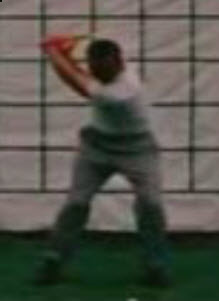
It’s a different way to get to the same position.
Dysfunctional Internal Rotation Moves
In this light, a bad over the top swing is primarily caused by lack of external rotation of the hips which leads to lack of rotational energy being generated by the glutes and lack of contralateral pull from the left glute to pull on the right lat to create lateral bend. The lack of lower body rotational energy forces the upper torso and arms to supply the needed power thereby losing a chance to set up the lateral bend correctly. Thus we see the upper body rotation early and call that an “over the top” swing.
So it leads to the question, what are these people doing if they aren’t doing ER? They are doing internal rotation.
Ground Up Swings
Here’s an example of what happens when you try to start the swing from the ground up by pushing from the ground. You will typically be using right leg internal rotation. This will use up this movement prematurely when it should be used later in the swing.
Also, this shifts the weight directly on the ball of the left foot and with that much weight on the front foot, it will inhibit LHER thereby severely limiting pelvic rotation. That can’t be good.
Double Hip Internal Rotation
Here’s an example of this sort of dysfunction. This long-time golfer was obsessed with keeping his weight on the insides of his heels and keeping his knees in. Shall we say IR in both hips and knees? Thus he’s effectively inhibiting pelvic rotation as you can see.
You could try this yourself. Point both knees inward and keep them still while attempting to rotate your body. You can’t rotate very far.
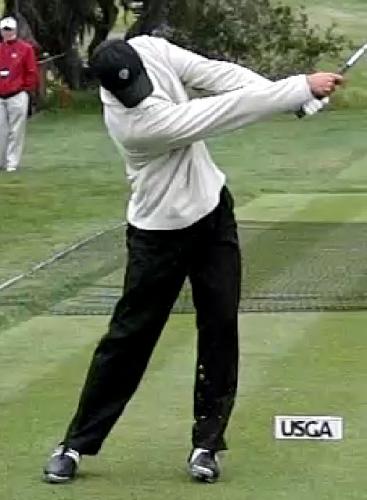
What happens when PGA tour players do IR in both hips at the start of the downswing? Is it any different? Distance challenged Brian Gay might be very accurate but at what cost?
Once again we see IR hindering pelvic rotation which is another way of saying it causes the hips to move slowly during this transition/early downswing phase.
Then how does it affect the rest of the downswing?
Without the hips in the dual ER and ADD, there is not much movement it can make. Thus we see only extension of the hips/legs at impact. Does this affect the amount of clubhead speed one can generate???
Segment Interaction Principle
Perhaps another way of looking at this is that driving the legs into IR is absolutely what these people promoting the kinetic chain are seeing. So they are right. It does exist in less than optimal usage of one’s body. But they are looking at non-legendary swings and seeing the stalls or braking, then coming to the conclusion that this is a great way to swing. Oh well…
Later we shall see how this position affects the second half of the downswing.
Dual Abduction
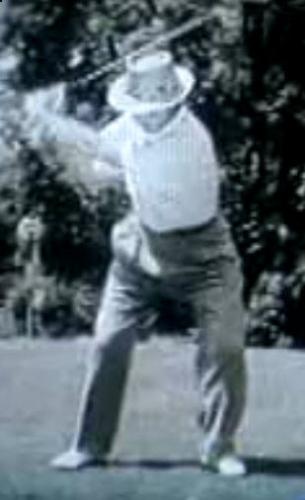
AB in the golf swing is when the leg becomes more angled outward when looking at a front view of the golfer. Perhaps this is what people think of as the squat move. They see the slight outward appearance of the femurs.
Abduction (AB) is a set up move for a SSC firing which will occur later in both hips adducting (ADD).
But if one femur is positioned more vertical than the other, it is likely that some IR could be involved as well as moving one hip into ADD.
Here’s a more aggressive leg drive model that doesn’t look quite as legendary. If you’ll watch the legs of Nicolas Thompson, he’s driving and pushing with the legs. Thus he is pushing into RHIR as well as ADD way early.
Nic is in a similar position as Brian Gay is but since he’s so used to driving his legs hard he keeps on driving them. Technically, his legs/knees do not extend therefore the knees stay bent. Also his left hip does not move into IR near impact. Instead, he drives LHER at impact. This keeps him sliding toward the target instead of seeing the left hip pulling back and away from the target like the legends.
Early Left Shift Syndrome
Many people over-exaggerate the early left shift of Hogan. Though Hogan began to shifting left earlier in his swing the older he got, this isn’t the era when he was in his prime. Compare this to the player below.
Right after the takeaway he’s shifting left.
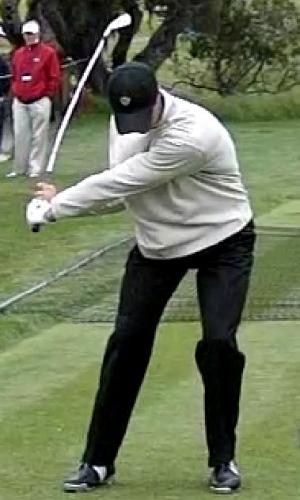
Then, unlike Palmer, stays in the closed slide for way too long. Notice his left femur is more vertical than his right. This means his left hip is adducted and not abducted. Due to this, there is an absence of dual ER and symmetrical AB.
This places more weight onto the left leg and will ultimately cause a stall or a hip slide.
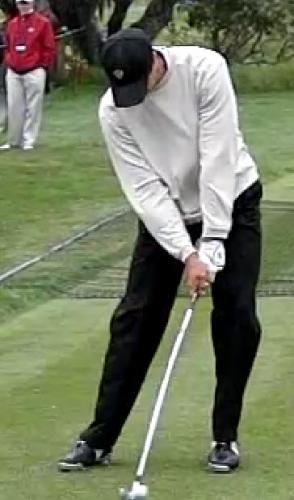
He’s had great lag and nice shaft lean at impact but his body looks like it’s not moving very much. Nice but not legendary.

Is that what Hogan in his prime looked like? Don’t think so.
Dual Hip Flexion
The drop of the hips, anterior pelvic tilt, increase in lordosis and the weight shift have their origins in the flexion of the hips. Instead of just dropping from gravity, the iliopsoas, the major muscles involved in bringing your leg up toward your chest when running, is also capable of pulling the hip bone down. Of course this is a set up move for the power move involving extension of the hips to come later.
In young Jack’s swing you can see the flexion of both hips/legs and how this causes a drop and the weight shift to occur. You can also see his belt tilt downward which shows the tilting of the pelvis.
From this view, the right knee movement has a circular movement.
Early Extension
Ross Fisher has a bit of a different move. He pushes with his right leg into early left hip/leg extension. This causes a weight shift to the left but also causes early ADD in the left leg. Thus he has no drop in transition.
Thus, his downswing is lacking the proper sequencing, he does not fully externally rotate the left hip and the available moves he has at impact are limited to jumping or extension of the hip and legs.
Power Phase of the Downswing: The Fearsome Foursome
After powering to the squat position, the actions in the left and right side are slightly different in timing but other than that they are remarkably symmetrical. This should make sense since, if the intended outcome is rotational speed and movement, the actions would show intuitive ways the legends swung to create force coupling or push-pull movements in their lower bodies.
Dual Extension of Hips and Legs
Extension should occur in both hips and legs. But while hip extension is a given, leg/knee extension is not. The legends all had dual extension in both hips/legs. When we see the hips or the belt buckle rising, this is due to the hips and the knees extending.
Young Jack Nicklaus was absolutely powerful.
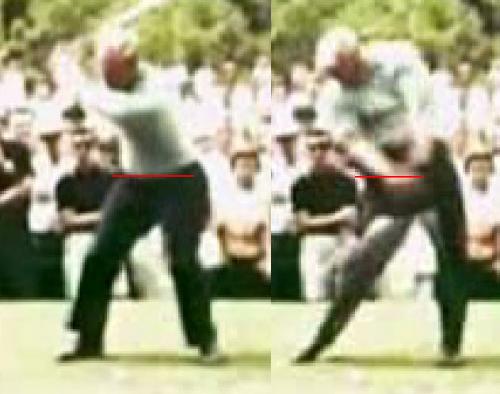
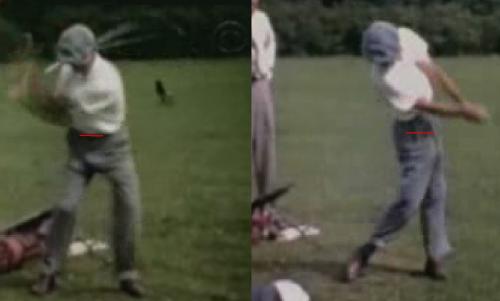
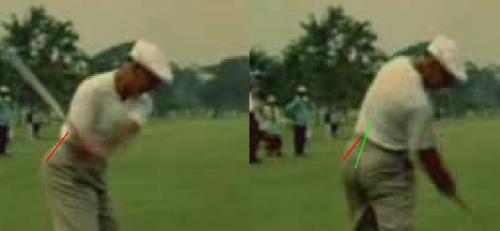
Here’s Hogan with the extension of the lower spine while his spine is still laterally bent.
Less than optimal use of the legs would be an increase in the bend of the legs during this phase. Here’s Chris Tidland from the Justin Timberlake Classic 2010. Notice his belt buckle is dropping all the way till impact. This is dual flexion in the knees continuing all the way till impact.
Dual Adduction
We see this movement in baseball. Power hitters bring their thighs closer together to snap the hips. This creates tremendous rotational power due to the anatomical positioning of the muscles on both sides of the pelvis producing a force coupling or push-pull effect.
This allowed Palmer to get into the great squat position that Snead and Hogan used.
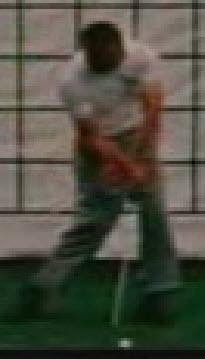
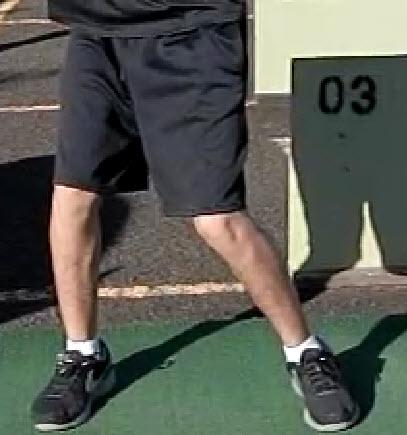
Less than optimal use of the hips would be to leave the knees apart or without adducting the hips.
Dual Internal Rotation
The hips/legs must be in the right position for this to occur properly. The left hip especially needs to be at or very near to max ER in order for the IR to work. If LHER is at max point, there is more LHIR movement available. Also, the femur would be in a position where the leg/hip extension could aid in pulling the left hip back in IR.
See Hogan’s ER in both legs making for a powerful dual IR?
Snead’s LHER occurs a bit earlier when his left arm is at about waist high on the downswing. This triggers a SSC firing to LHIR plus the ADD and extension at impact. This is when we see the left leg straightens and the left glute pulls back to fire the hips to rotate through impact.
Here’s Palmer with max LHER then moving to fire LHIR. This is the final power phase of the swing that pulls the left hip back and away from the target. It is at this point that the legends all float/rotated their left leg by unweighting the left foot and allowing it to rotate through impact.
Some Errors
Less than optimal position would have the left hip held in IR and in ADD as we have seen earlier and this means that the only available motion is leg/hip extension near impact. This creates a jump/stall.
This same idea holds true for the right hip. The more pushed into IR early in the downswing, as we have seen, this movement is used up and then all the hip can do is extend and adduct. This would typically cause stalling.
Late to Max LHER
Many golfers holding IR or that have shifted their weight too far to the left at the start of the downswing might make an attempt to LHER near impact but this just causes a slide of the hips.
LHIR missing?
Jim Furyk pushes into RHIR at the start of the downswing. The left side does well to create a small squat move. So he’s almost a legend in terms of his swing.
But then the rest of the downswing he’s RHIR and ADD but without much extension of the legs nor is the LH moving to IR. Instead it stays in ER and flexion creating the endless slide through impact. Thus, there is no symmetrical push-pull of the hips and no use of flexion in the legs. This means he’s using just two out of the fearsome foursome of power.
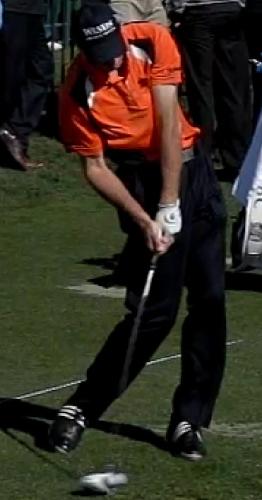
Furyk’s hip motions are very right side dominant. He continues to push and extend the leg/hip through impact in an effort to supply the rotation. But this is a little like trying to slam a door when the doorjamb keeps moving away.
Furyk’s success is attributed to his accuracy and consistency. Want to know why he is so accurate?
His hands are so stable through impact. Notice he looks supinated early before impact and just drive/holds it through impact. No flip. No roll. Just driving through very stable.
Footwork
While some experts believe that the footwork can cause or induce hip rotation, I don’t think that’s a valid way to look at it. The motion starts in the spine and pelvis. Then the hips, legs and feet can either facilitate or hinder rotations. This is an important distinction because your feet alone can’t cause what we call hip rotation.
http://www.youtube.com/watch?v=n1pcxTLcyA4
LHER should cause the left foot pressure to be on the outside of the left foot prior to impact. This will enable the left leg to rotate instead of being on the ball of the foot which would inhibit ER. Watch the full motion of Ian Poulter’s footwork.
http://www.youtube.com/watch?v=m-68_3vM7pQ
If the weight is on the front/ball of the left foot, it will keep the left hip in IR and ultimately hinder lower body rotation as you can see in Padraig Harrington.
http://www.youtube.com/watch?v=4eQtU9JrUyE
In case you didn’t know, Paddy surely swung better in 2008. While he wasn’t quite legendary, he certainly was better than he is now.
Summary of SSC action
To simplify this, let’s go back and summarize the stretch shorten cycle actions of the hips. Remember that stretch shorten cycles are the way we can use the muscles, tendons and ligaments to store elastic energy for powerful contractions. The faster the stretch, the more powerful the ensuing contraction. Also, the sooner the stretch is used in contraction instead of delaying, the more powerful the SSC will be. Here are the key SSC actions.
Abduction >>> Adduction
When the legs Abduct or move apart, this sets off SSC firing to adduct or move in.
Flexion >>> extension
When we flex or tilt the hips forward, this will set off SSC firing to extend or tilt the hips back.
Leg Flexion >>> leg extension
Hip extension should not be confused with the leg/knee flexion or bending that will set off SSC firing in the leg to extend or straighten.
RHER >>> RHIR
In transition, the RHER should fire to set off RHIR later in the downswing.
LHIR >>> LHER >>>LHIR
Not mentioned before but all legends used their left leg to internally rotate at the end of their backswings to create a leg whipping motion similar to a baseball pitcher to create a SSC for LHER to start the downswing.
LHER >>>LHIR
After the LH reaches max ER, this should set off final firing of the left hip to IR just before impact.
Connecting the Dots
Weight Shift
The weight shift should not occur by a conscious push from the legs. As we have seen, this will tend to move one or both of your hips into early IR and you will reach the end of your available rotation very quickly and stall.
The weight shift comes from the dual motions of ER, AB and flexion in both hips/legs. And if you’re like Arnie and you’re already on the left on the backswing, there should be no more shifting farther to the left.
Closed hip bump is over-exaggerated and thus no ER
Related to the idea of weight shifting, most people are over-exaggerating the closed slide. The effect of dual ER, AB, and flexion in the hips will cause enough of the closed slide as is necessary while not doing too much. If your left hip moves into ADD and the femur stays in the vertical position for too long, you are most likely staying in IR and losing ER.
Contra-lateral Connection
Watch a young Hogan from the back view and you can see the left glute firing to create ER while his right shoulder drops. This shows the contra-lateral connection of the left glute (primary firing in LHER) to the right latissimus dorsi begins rotation AND the lateral bend of the right side. In golf terms, this is part of the mechanism that allows you to drop your right shoulder and club into a flatter plane.
Efficiency or Inefficiency?
Many teachers like to throw around these catch words like “efficiency” or “efficient.” In the case of a golf swing and movement of the pelvis/hips, would you rather have an efficient moped engine or a gas guzzling top fuel dragster engine? Want to burn a tablespoon of fuel vs. 15 gallons in a quarter mile race? The legends intuitively knew how to use the maximum available moves to create beautiful motion instead of giving up or removing moves that causes stalling, endless lateral motion or jumping. By using all the available moves, their swings were inefficient by today’s standards because each of these moves recruits more muscles and therefore consumes more gas (of course gas for muscles is adenosine triphosophate or ATP and we’ve got lots available for a one second golf swing).
An example of this would be if one holds his right leg firm on the backswing in IR, then pushes into early IR and ADD in transition, the result is a loss of ER, AB and possibly flexion in transition. This means that virtually all the muscles involved in active ER, AB and flexion become stabilizers or passive during the swing and you’ll lose SSC’s that will automatically fire into the triple threat of power moves. That’s efficiency! And someday a moped will win a top fuel dragster race! Right...
Fearsome Foursome in Other Sports
Baseball Pitching
Cy Young Award winner Tim Lincecum has one of the best throwing motions in baseball that uses his body the way the legends swung a golf club. Notice the ER, AB and flexion? This allows him to use all the muscles in his pelvis and groin area that turns him into a dragster. Notice his right foot slides or is pulled by his pelvis. It is more than a foot and a half in front of the mound by the time he releases the ball. But of course you don’t have to pitch like this.
Here’s another pitcher Ubaldo Jimenez that might be a candidate for arm trouble. By pushing his right leg into IR early in the forward motion, he doesn’t have this motion available to him during the release. This is the same as saying he’s only throwing with his arm at this point. Sounds like Segment Interaction Principle is at work here but this is potentially dangerous to his arm and elbow. This is so similar to the golfers that are pushing into RHIR early in transition. Notice his right foot is pushing off the mound so his foot looks glued to the rubber.
Baseball Hitting
Here’s St. Louis Cardinals baseball player Albert Pujols doing ER/AB/flexion in both hips but especially unique is his RHER. The future Hall of Famer certainly uses the hip movements that the legendary golfers used.
Who says golf and baseball have to be so different? Could it be that a poor baseball swing makes a poor golf swing? In that case the problem isn’t that the two sports are so different. A bad swing is a bad swing regardless of the sport.
Tennis Serving
2005 Wimbledon doubles champion Wesley Moodie is a serve and volley player with a great serve. Notice the ER/AB/flexion in both legs before driving his body up.
Compare Moodie to Alize Cornet who was ranked as high as #11 in the world. She is known for having great groundstrokes but a weak serve. There’s a lot of flexion in the knees and hips but what about AB and ER? This is clearly a case of efficiency! She’s certainly using less of her available hip movements and therefore fewer muscles.
Nadal Backhand
Notice he uses the moves - especially notice his right hip just before jumping.

Why do frogs have their legs in an externally rotated and AB position?
To illustrate how the body can work and involve more muscles, let’s do a simple drill. Do a vertical jump with your knees pointed in. This removes AB and ER. Then try a vertical jump with your knees pointed out or externally rotated and add those moves back into the motion. The muscular force you can summon while knees are pointed in is limited somewhat to the leg muscles. By externally rotating the hips, you can involve a lot more of your pelvic muscles.
This should show you how complex the interactions of the pelvis and legs are even when doing something as simple as jumping.
Sprinting
It was really odd to find this gem. Ever since I can remember, track coaches taught that your legs and arms should pump straight up and down to run faster and more efficiently. This made so much sense because with less motion wobbling or orbiting around circularly it would seem that you would move in a straighter line therefore move the limbs faster. But we are not robots. The spine is rotating while running so how can you remove rotational motion from your limbs even if you are tried? And would removing rotational movements make you faster?
World class sprinter Asafa Powell displays a circular motion of his femurs. Notice the ER/AB/flexion when the leg comes up and IR/ADD/extension when the leg pushes in the power phase. Perhaps this is the all powerful genetic code of the hips/legs expressing itself in the most fundamental movement of the human body.
In case you have doubts that this is an anomaly, here’s Tyson Gay, top US sprinter who beat Usain Bolt recently in a 100m race.
Training Thoughts
Keep in mind that while this requires the four essential moves and five or six SSC firings, there’s no one that has all these movements wrong. Everyone’s got to have at least one or two done right and all you have to do is train the non-existent ones into your current movements so that you can build this into your swing rather than start from scratch.
Also, this will help clarify the muscle movements that need to be trained. For example, instead of generically understanding that the glutes are important (yes they are!), we need to understand how they move and therefore, how should they be trained??? Doing squats or lunges will develop your glutes but is this how they move in a golf swing? The experts in physical training talk a good game of specificity. But their practical application suffers because they don’t know how the glutes work in a complex motion as in the golf swing. And it’s the same for every muscle and movement in a golf swing. Training needs to be specific to the movement pattern not just to the muscle that is moving!!!
Rotational Resistance Hip Trainer
I have developed a rotational hip trainer that will also train these movements in a very specific way. This training device is basically a lazy susan with a spring resistance that can train your glutes and pelvic muscles while hitting a golf ball. It is so good that I already have a MLB pitcher from the Washington Nationals that benefitted greatly from it.
Legendary Performance
When you break the swing down into these SSC firings and instinctual, athletic motions shared by other sports, this makes the swing much simpler to understand and perform. Golf is an athletic game and should be played like the legends once did. Pure as the wind driven snow were they. Untainted by modern technology, they did not have high speed video cameras to concoct a swing plane, a Trackman to produce a perfect D-plane or have a biomechanical sensor system to have them conform to a “theory” of motion. They just swung the club and hit the ball in the most athletic (not aesthetic) way. Perhaps Darwin would be proud as the fittest truly did survive and excel but he might be equally disappointed at the way the game is being taught today.
John Novosel Jr. of Kansas and Andrew Ludlow of Texas have completed their SSC golf spine engine level II certification. They are very knowledgeable in the ways to train these movements and can help you with your swing instead of having to visit Hawaii.
Videos to Study